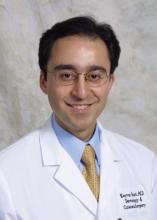BOCA RATON, FLA. – Experience with various lasers for the treatment and prophylaxis of nonmelanoma skin cancers is increasing, and the outcomes are promising.
One setting where lasers have particular potential is in patients with multiple basal cell carcinomas, Dr. Keyvan Nouri said at the annual meeting of the Florida Society of Dermatology and Dermatologic Surgery.
BCCs tend to have telangiectasias, and by specifically targeting the tumor vasculature, the BCC burden can be decreased or eliminated by laser treatment with little damage to surrounding skin. An ablative approach can also eliminate premalignant cells, said Dr. Nouri, professor of dermatology and otolaryngology and director of Mohs, dermatologic, and laser surgery at the University of Miami.
Studies using this approach have been conducted over the past several years using CO2, Er:YAG, pulsed-dye, and alexandrite lasers.
The 10,600-nm CO2 laser achieves a depth of 15-200 mcm in a single pass, which is adequate for coagulating the epidermis and superficial dermis, and for eliminating squamous cells at risk for evolution to actinic keratosis or squamous cell carcinoma. It also is partially effective for eliminating cells en route to basal cell carcinoma, he said, noting that deeper treatment can be achieved with multiple passes or protocol modifications.
In one study using this CO2 laser, 14 patients with diffuse facial AKs underwent resurfacing and experienced significant long-term reduction in AK burden (Dermatol. Surg. 1997;23:885-9). In another report of two patients with a history of multiple nonmelanoma skin cancer who were treated with two-pass CO2 resurfacing, no new lesions developed in the treated area at 33 and 52 months (Dermatol. Surg. 1999;25:513-16).
In a randomized controlled study of 34 patients, no differences in outcomes were seen at 5 years regardless of whether patients were treated with the CO2 laser, a 30% trichloroacetic acid peel, or 5% fluorouracil cream twice daily for 3 weeks. All of the treatments reduced AK counts by 83%-92%, and reduced the incidence of nonmelanoma skin cancers, compared with control groups (Dermatol. Surg. 1999;25:729-32), Dr. Nouri said.
In three of his patients with basal cell nevus syndrome, the Ultrapulse CO2 laser also proved effective for treatment. Postoperative Mohs micrographic surgical sections verified complete histologic clearance, and the patients had minimal scarring at follow-up (Dermatol. Surg. 2002;28:287-90).
A high-energy pulsed CO2 laser has also been used to treat a squamous cell carcinoma in situ on the nose with one pass (at 250 mJ, 8 W). In that case, no recurrence had occurred at 5 months’ follow-up, and the cosmetic result was excellent, Dr. Nouri said.
In a series of patients with nodular and superficial BCCs, a combination of curettage and one or two passes with the high-energy pulsed CO2 laser was also effective, with no histologic evidence or residual tumor and no known recurrences.
In another study, the pulsed CO2 laser was effective for treating 30 neoplasms, including 17 BCCs and 13 SCCs (Arch. Dermatol. 1998;134:1247-52). Two or three passes were used (at 500 mJ and 2-4 W). Treatment with a 4-mm margin and three passes is recommended for complete vaporization of neoplasms using this laser, Dr. Nouri said. Also, one SCC in situ in that study was incompletely ablated after three passes, so this modality alone is not recommended for thick or keratotic lesions, he said.
More recently, fractional laser resurfacing and pulsed-dye laser treatment have also shown promise for nonmelanoma skin cancers. In a pilot study of 28 patients with mild to moderate actinic damage who were treated with a fractional Er:YAG laser (2,940 nm) with one to four treatments at 4-week intervals, 75% had excellent results and the other 25% had good results. The effects were maintained at up to 9 months (Dermatol. Surg. 2008;34:1048-53).
And the 595-nm pulsed-dye laser has been used successfully to target tumor vasculature in glottal dysplasia and SCCs. Depending on fluence and spot size, the 595-nm pulsed-dye laser can penetrate skin to thicknesses ranging from 0.75 to 1.25 mm, which encompasses most BCCs, Dr. Nouri said.
In one study, a single treatment on seven BCCs resulted in histologic clearance of only one tumor (Lasers Med. Sci. 2003;18:125-6), but in two other studies of patients with superficial BCCs, this laser was associated with no clinical recurrences at a minimum follow-up of 1 year in 16 of 20 BCCs (Lasers Med. Sci. 2005;20:147-8; Dermatol. Ther. 2008; 21:402-5).
In another study, 20 BCCs treated with four 595-nm pulsed-dye laser treatments at 2-week intervals showed that nearly all BCCs less than 1.5 cm responded completely, compared with about 17% of controls. Larger BCCs had a complete response rate of 25% vs. 0% in controls.


